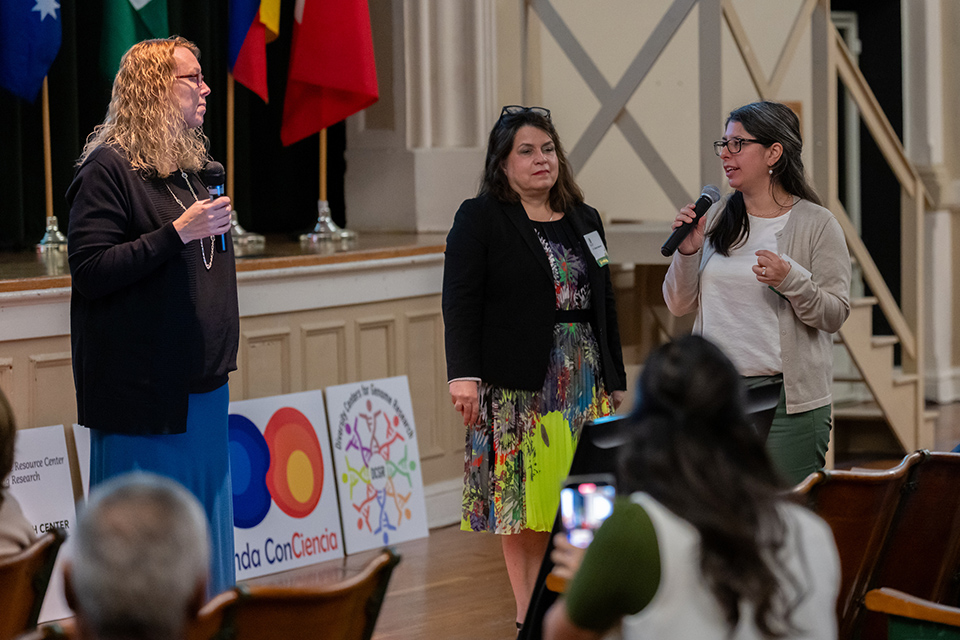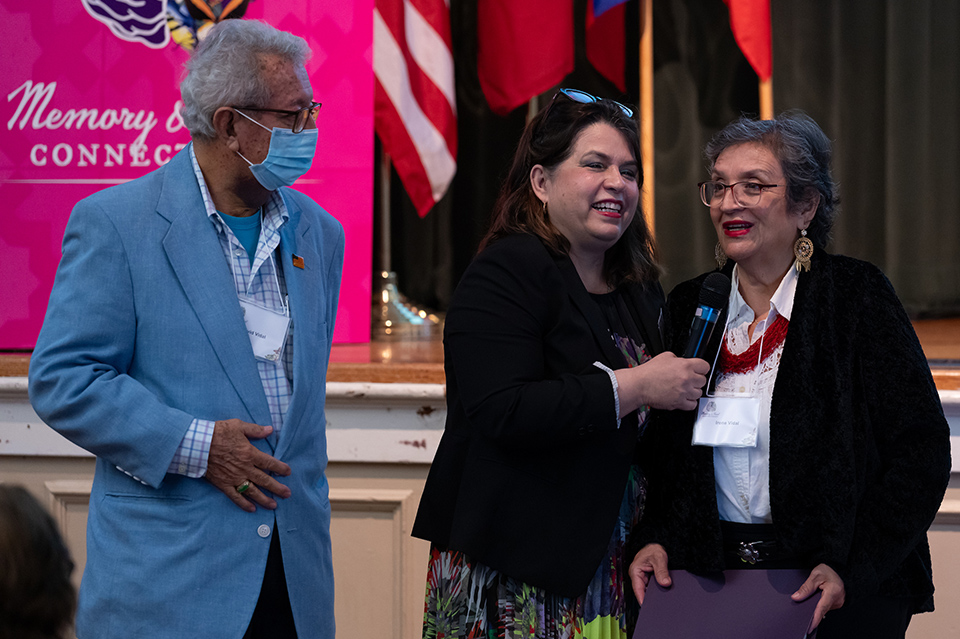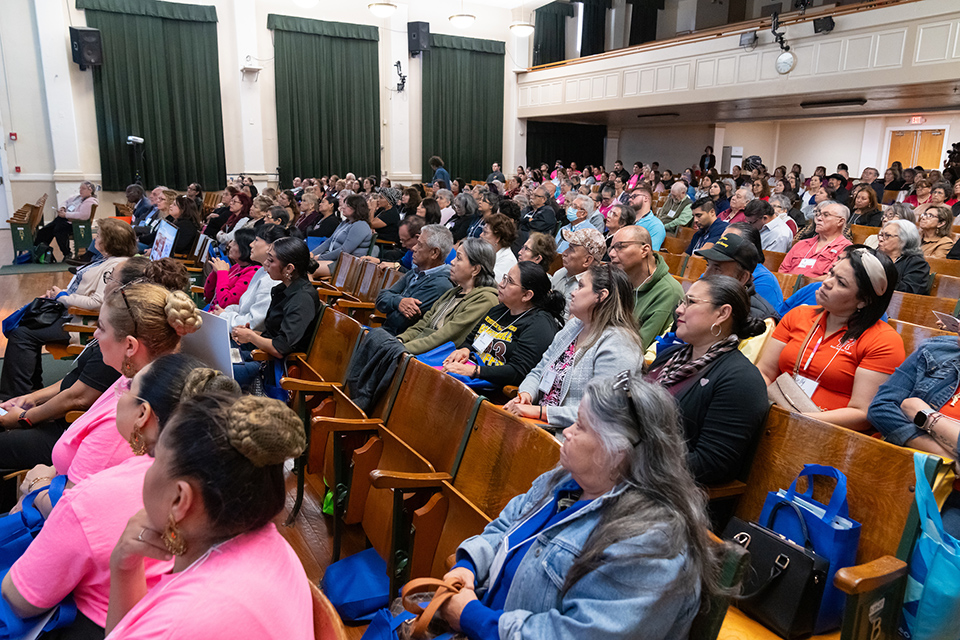By Karen Villarreal
SPECIAL NOTE: Feb. 14-21 is Alzheimer's and Dementia Care Education Week
RIO GRANDE VALLEY, TEXAS – FEB. 7, 2025 – Although Hispanics are at higher risk for Alzheimer’s Disease and Related Dementias (ADRD), lifestyle choices can enhance cognitive function and brain flexibility, ultimately improving the quality of life for individuals with ADRD and their families.
Experts from the UTRGV School of Medicine, UT Health San Antonio, and institutions in Italy, Nigeria and Florida presented this research-backed information to more than 350 members of the South Texas community at the free event “Memory & Heart Connections.” The event was hosted by UTRGV’s Alzheimer's Disease Resource Center for Minority Aging Research (RGV AD-RCMAR) on Jan. 30.
According to the South Texas Alzheimer's Disease Research Center, Texas ranks fourth in the nation for Alzheimer’s Disease cases and second for related deaths.
Dr. Gladys Maestre, director of RGV AD-RCAMAR, expressed gratitude to community partners and research participants in attendance.
“We do research and service, but we would be nothing without our community,” she said. “We learn together.”
In the Rio Grande Valley, counties report some of the highest rates of ADRD in the state, with prevalence rates of 15.5 percent in Starr County, 14.8 percent in Hidalgo and Willacy counties and 14.6 percent in Cameron County.
David Vidal, a community member who has participated in research with RGV AD-RCMAR over the past year, shared his insights on healthy aging gained from the studies and presenters.
“We know there’s a possibility to get it, but we do what we can do ourselves to prevent dementia from affecting us soon,” he said. “There are opportunities to keep living with an alert mind, and we try to live healthily to stay of use to society.”
BEYOND GENETIC PREDISPOSITION
Dr. Joanne Curran, a professor of Human Genetics at UTRGV SOM and a researcher with the South Texas Diabetes and Obesity Institute, discussed findings from their extensive family studies. She noted that some risk factors for ADRD are unrelated to genetics, such as exposure to environmental pollutants and toxic metals.
Curran explained that while certain genetic mutations, like those in the BRCA1 and BRCA2 genes, are strongly linked to specific diseases, complex diseases such as diabetes, hypertension and ADRD are influenced by multiple genes.
“We consider these diseases to be caused by more than one gene, and we don’t know all these yet. There are generations of research to be done before we can predict the risk associated with them,” she said.
Dr. Claudia Satizabal from UT Health San Antonio and the Biggs Institute, along with Dr. Adesola Ogunniyi from Nigeria’s University of Ibadan, presented findings on lifestyle choices that significantly reduce the risk of ADRD.
“From a perspective of prevention, good metabolic health is very important,” Satizabal emphasized. “This includes diet, sleep, physical activity and social habits.”
HABITS FOR BRAIN HEALTH
Ogunniyi’s research-based recommendations include following a high-quality diet, such as the DASH (Dietary Approach to Stop Hypertension) or a Mediterranean diet. A 2023 study found that these diets can reduce dementia risk by up to 23 percent. The MIND diet (Mediterranean-DASH Intervention for Neurodegenerative Delay), a hybrid of the two, was associated with a reduced risk of Alzheimer’s and a slower rate of cognitive decline.
After an average of 4.5 years, individuals who adhered closely to the MIND diet experienced a 53 percent lower rate of Alzheimer’s compared to those who did not follow the diet closely.
Ogunniyi also recommended getting seven to eight hours of sleep per night, noting that a 2021 study found that sleeping less than 5 hours per night doubled the risk of developing dementia. Additionally, he suggested 150 minutes of moderate-intensity physical activity each week, as obesity increases risk by 30 percent.
Maestre emphasized that physical activity should be something individuals enjoy and feel comfortable doing, noting that consistency is essential.
THE POWER OF SPACES
Yohanny Albornoz from Miami’s Human Sensory Studio & Consulting firm, Discover Neuroarchitecture, spoke about designing spaces that enhance brain function, mood and physical well-being.
She shared that patients with a view of nature recovered faster and required less pain management compared to those in gray-walled room.
“I believe spaces transform lives,” Albornoz said.
She said that organized and “legible” spaces can promote mental calm. Daily environments can be made more enjoyable and meaningful by incorporating elements of nature and art.
Albornoz also discussed the role of public art, which can break monotony and evoke emotional experiences.
“It can reflect cultural values that foster a sense of belonging, which triggers memory,” she said.
Davide Ruzzon from POLI.Design Technical University in Milan, Italy, advocated for public spaces that encourage movement and social interaction, as these activities are protective factors against mental decline.
Ruzzon noted that the architectural design of institutions helps individuals process spatial experiences. He explained that schools and hospitals are often built in familiar shapes to meet public expectations.
“A lack of attunement between what we seek and what we find causes stress, which is one of the risk factors listed for damaged cognition,” Ruzzon explained.
To learn more about UTRGV’s Alzheimer's Disease Resource Center for Minority Aging Research, visit www.utrgv.edu/school-of-medicine/departments/alzheimers-disease-resource-center.
ABOUT UTRGV
The University of Texas Rio Grande Valley (UTRGV) was created by the Texas Legislature in 2013 as the first major public university of the 21st century in Texas. This transformative initiative provided the opportunity to expand educational opportunities in the Rio Grande Valley, including a new School of Medicine and a School of Podiatry, and made it possible for residents of the region to benefit from the Permanent University Fund – a public endowment contributing support to the University of Texas System and other institutions.
UTRGV has campuses and off-campus research and teaching sites throughout the Rio Grande Valley including Brownsville (formerly The University of Texas at Brownsville campus), Edinburg (formerly The University of Texas-Pan American campus), Harlingen, Weslaco, McAllen, Port Isabel, Rio Grande City and South Padre Island. UTRGV, a comprehensive academic institution, enrolled its first class in the fall of 2015; the School of Medicine welcomed its first class in the summer of 2016, and the School of Podiatric Medicine in the fall of 2022.



